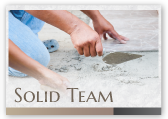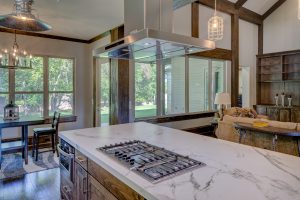The area of material behind your sink– whether in the kitchen, bathroom, laundry room or wherever… You probably take it for granted! The truth is that backsplashes are a relatively new innovation in home design.
ORIGINS
A backsplash is designed to prevent water, grease and other liquids from staining the wall behind a sink. Short, functional backsplashes were likely introduced when indoor plumbing became common in homes and businesses. This new convenience was soon adapted for other purposes such as decor and luxury.
EVOLUTION
As design evolved, some sinks were created with their own backsplashes– often called “farmhouse-style.” By the mid-1900s, bright and patterned tiles became the popular choice for a backsplash. In the 80s and 90s, style moved towards neutral colours like cream, beige and off-white.
MODERN &BEYOND
Recent years have seen the popularization of elements like stone, metal, ceramic and glass. Designs range from simple mosaics inspired by midcentury subway stations to intricate patterns that combine different materials. When it comes to the future of backsplashes– the sky is the limit! Contemporary trends include diverse textures, faux-materials like wood and even a return to bold 1950s patterns.
If you have questions about adding or changing a backsplash, contact or visit us today! The experts here at Stoneworks will walk you through the numerous options in design and material available for any backsplash project.




 A wide open kitchen with a central island area is a common sight in modern homes, but it was not always this way. Design evolved from classical, more temporary use to what is now widely considered a cornerstone of today’s kitchen. Keep reading for Stoneworks’ crash course in the history, evolution and status of the kitchen island.
A wide open kitchen with a central island area is a common sight in modern homes, but it was not always this way. Design evolved from classical, more temporary use to what is now widely considered a cornerstone of today’s kitchen. Keep reading for Stoneworks’ crash course in the history, evolution and status of the kitchen island. Custom backsplashes– the part of your kitchen wall behind the sink– have become extraordinarily popular in recent years. Ranging in material and style, both new builds and renovations tend to boast a bodacious backsplash that catches the eye. Whether to add style or value to your home, backsplashes are often good investments, but only if they remain in peak condition. Consult Stoneworks’ guide to backsplash maintenance below and be sure to contact our professional customer service team with any concerns.
Custom backsplashes– the part of your kitchen wall behind the sink– have become extraordinarily popular in recent years. Ranging in material and style, both new builds and renovations tend to boast a bodacious backsplash that catches the eye. Whether to add style or value to your home, backsplashes are often good investments, but only if they remain in peak condition. Consult Stoneworks’ guide to backsplash maintenance below and be sure to contact our professional customer service team with any concerns.


